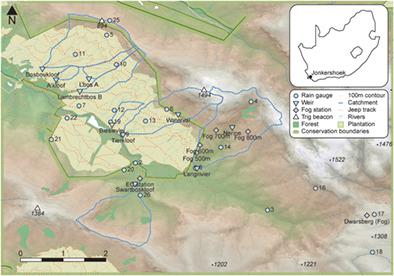当前位置:
X-MOL 学术
›
Hydrol. Process.
›
论文详情
Our official English website, www.x-mol.net, welcomes your
feedback! (Note: you will need to create a separate account there.)
Jonkershoek: Africa's oldest catchment experiment ‐ 80 years and counting
Hydrological Processes ( IF 2.8 ) Pub Date : 2021-02-23 , DOI: 10.1002/hyp.14101 Jasper A. Slingsby 1, 2 , Abri Buys 1 , Adrian D. A. Simmers 3 , Eric Prinsloo 4 , Greg G. Forsyth 5 , Julia Glenday 1 , Nicky Allsopp 1
Hydrological Processes ( IF 2.8 ) Pub Date : 2021-02-23 , DOI: 10.1002/hyp.14101 Jasper A. Slingsby 1, 2 , Abri Buys 1 , Adrian D. A. Simmers 3 , Eric Prinsloo 4 , Greg G. Forsyth 5 , Julia Glenday 1 , Nicky Allsopp 1
Affiliation

|
The Jonkershoek Forestry Research Station was established in the Mediterranean climate region of South Africa in 1935 to implement a multiple catchment experiment to determine the effects of afforestation on water yield. The experiment consists of six neighbouring catchments previously supporting indigenous fynbos shrublands, five of which were sequentially afforested with Pinus radiata plantations every 8 years from 1940 to 1980 and one kept as the control. They conclusively demonstrated a significant impact of afforestation on streamflow. The treatment catchments have seen subsequent plantation rotations since 1980 and rainfall and streamflow observations have been continued to date. Here we describe the site, experimental design, rainfall and streamflow records, instrumentation, and how to access the data. We also provide details of recently installed instrumentation, including full weather stations, fog gauges, and an eddy covariance flux tower. The Jonkershoek catchment experiment was the core of a globally significant interdisciplinary research programme (1935–1992) that shaped most environmental policies and practices relating to biodiversity, forestry, fire and water in South Africa and beyond. The South African Environmental Observation Network (SAEON) inherited the experiment in 2010 and is maintaining it as a long‐term eco‐hydrological research platform and global change observatory.
中文翻译:

Jonkershoek:非洲最古老的流域实验-80年,而且还在不断增加
Jonkershoek林业研究站于1935年在南非的地中海气候地区建立,目的是进行多次流域试验,以确定造林对水产量的影响。该实验由六个相邻的流域组成,这些流域以前曾支持土著的小灌木丛灌木丛,其中五个依次被辐射松绿化。从1940年到1980年,每8年种植一次,作为对照。他们最终证明了造林对河流流量的重大影响。自1980年以来,处理集水区随后发生了人工林轮作,迄今为止,降雨和水流观测仍在继续。在这里,我们描述了场地,实验设计,降雨和水流记录,仪器以及如何访问数据。我们还提供了最近安装的仪器的详细信息,包括全气象站,雾度计和涡流协方差通量塔。鸡场流域实验是全球重要的跨学科研究计划(1935年至1992年)的核心,该计划塑造了与南非及其他地区有关生物多样性,林业,火灾和水的大多数环境政策和实践。
更新日期:2021-04-27
中文翻译:

Jonkershoek:非洲最古老的流域实验-80年,而且还在不断增加
Jonkershoek林业研究站于1935年在南非的地中海气候地区建立,目的是进行多次流域试验,以确定造林对水产量的影响。该实验由六个相邻的流域组成,这些流域以前曾支持土著的小灌木丛灌木丛,其中五个依次被辐射松绿化。从1940年到1980年,每8年种植一次,作为对照。他们最终证明了造林对河流流量的重大影响。自1980年以来,处理集水区随后发生了人工林轮作,迄今为止,降雨和水流观测仍在继续。在这里,我们描述了场地,实验设计,降雨和水流记录,仪器以及如何访问数据。我们还提供了最近安装的仪器的详细信息,包括全气象站,雾度计和涡流协方差通量塔。鸡场流域实验是全球重要的跨学科研究计划(1935年至1992年)的核心,该计划塑造了与南非及其他地区有关生物多样性,林业,火灾和水的大多数环境政策和实践。











































 京公网安备 11010802027423号
京公网安备 11010802027423号